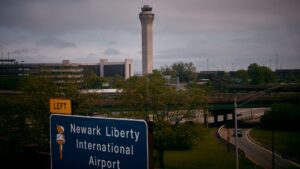Navigating Turbulence: The Crisis in Air Traffic Control at Newark Liberty International Airport
On May 6, 2025, Newark Liberty International Airport was back in the news, but not for the right reasons. A mere 90-second equipment failure revealed just how fragile our air traffic control system has become—one rooted in decades of staffing shortages and underinvestment. As air traffic controllers struggled to manage some of the world’s busiest airspace, over 1,500 flights were delayed, leaving thousands of travelers stranded and their plans in disarray.
A Close Call: What Went Wrong?
On April 28, chaos ensued at a Philadelphia air traffic control facility overseeing Newark flights. Controllers suddenly found themselves staring at dark radar screens, unable to communicate with incoming and outgoing aircraft for upwards of 90 seconds. Though it may seem like a brief interlude, for aviation professionals, that amount of time can feel like an eternity, especially when managing the complexity of air traffic.
As Jeff Guzzetti, a retired investigator from the National Transportation Safety Board explained, "An outage of even a few seconds is critical." Pilots are trained to handle such situations, but the stress and intensity for controllers can be overwhelming, leading some to take time off after particularly intense incidents.
The Domino Effect of Disruption
United Airlines was especially hard hit by the outages. Following the April incident, they announced a reduction of 35 flights per day to mitigate strain on their operations. With a runway also closed for construction, Newark’s challenges are compounded. It’s a perfect storm of issues, exacerbated by the chronic understaffing of air traffic controllers, which industry executives see as directly hampering their operations.
Attempts to Fix a Broken System
In response, the Federal Aviation Administration (FAA) has committed to increasing staffing at the Philadelphia facility responsible for Newark flights. A temporary backup system is also in the works to enhance reliability. Transportation Secretary Sean Duffy is expected to unveil a comprehensive upgrade plan for the U.S. air traffic control system, which could require new congressional funding. The urgency is palpable; many of the systems in use today date back to the 1990s.
Nick Daniels, president of the National Air Traffic Controllers Association, highlighted the dire situation, noting, "We have computers in 2025 that are based on Windows 95 and floppy disks." With an average age of 40 years for many of the FAA’s towers and radar systems, the call for modernization has never been more evident.
Safety on the Line: A Wake-Up Call
While the recent outages did not lead to accidents, they have reignited concerns about the safety and reliability of an aging air traffic control system during a critical time. The tragic collision of a Black Hawk Army helicopter with an American Airlines regional jet in January—resulting in the loss of all 67 lives—heightened the focus on air traffic control deficiencies.
It often takes a stark tragedy to galvanize efforts toward meaningful change, and this incident has clearly done that.
Why Newark Faces Unique Challenges
Newark, which handled approximately 414,000 flights last year, is currently contending with severe space constraints. It is considerably smaller than nearby John F. Kennedy International Airport yet handles a similar volume of air traffic. The FAA’s 2022 decision to relocate controllers from Long Island to Philadelphia was aimed at alleviating congestion, but as we’re witnessing, significant issues remain.
United Airlines CEO Scott Kirby emphasized this point in a recent memo to employees, stating, "Without enough controllers, it is now clear that Newark airport cannot handle the number of flights scheduled in the coming weeks."
Addressing the Controller Shortage
Currently, the United States has about 10,800 air traffic controllers—3,000 short of its optimum staffing level. Recruitment is a significant hurdle, with only around 10% of applicants ultimately completing training and being assigned to positions.
Recently, Duffy has pushed for higher salaries and improved financial incentives to attract new talent. While starting salaries hover around $45,000, the median salary for a controller can reach $144,580 annually, a figure that might need to increase to effectively draw in new recruits.
The Path Forward: Collaborative Solutions
While current challenges are significant, they aren’t insurmountable. The aviation industry is calling for more robust regulations to limit flight numbers at congested airports like Newark, echoing sentiments for a more sustainable and efficient approach to air travel.
"Past failures to address overcapacity have led us to the challenges we face today," Kirby wrote. The upcoming FAA plans for modernization could pave the way for a more reliable air travel experience for everyone.
At Extreme Investor Network, we believe the future of air travel, stunningly complex and ever-changing, can benefit from innovative solutions that prioritize efficiency, safety, and accountability. As we continue to monitor developments in this critical sector, we invite our readers to engage with and share their thoughts on how best to navigate these turbulent skies.
Stay tuned for more insights and updates as this story unfolds. The future of air travel hangs in the balance, and only through proactive measures can we ensure a smoother ride for all.

